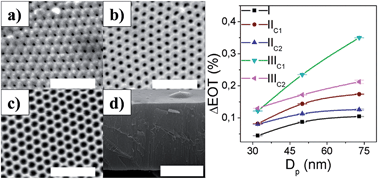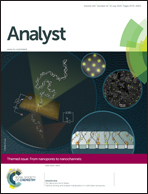Effect of pore diameter in nanoporous anodic alumina optical biosensors†
Abstract
The influence of pore diameter over the optical response of nanoporous anodic alumina (NAA) films is analyzed by reflectance interference spectroscopy. NAA films manufactured by a two-step anodization procedure in oxalic acid exhibiting three well-defined pore diameter distributions with pores of 32 ± 4, 50 ± 3, and 73 ± 2 nm are studied. The optical detection of biomolecules is investigated by serially dosing protein A, human IgG and anti-human IgG into a nanoporous matrix using a custom-made flow cell. The results demonstrate that the transduction signal, the variation of effective optical thickness upon IgG binding to protein A (ΔEOT), depends on the nanopore diameter: for small pore diameter (32 nm) no significant differences in signals are observed for different protein concentrations whereas for larger pore diameters (50 nm and 73 nm) the signals increase for increasing concentrations from 10 to 100 μg mL−1. Our experiments also show that this signal can be further enhanced by amplification with anti-human IgG due to the multiple binding events between the antigen and the antibody. These results will enable the development of more sensitive interferometric biosensors based on NAA.

- This article is part of the themed collection: From nanopores to nanochannels

 Please wait while we load your content...
Please wait while we load your content...